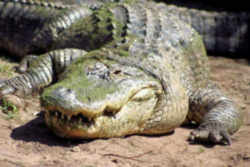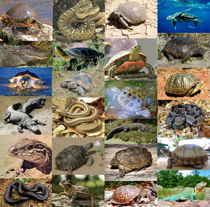
Louisiana Symbols
Louisiana State Reptile
Alligator

(Alligator mississippiensis)
Adopted in 1977
The alligator was adopted as Louisiana's state reptile in 1983. It lives in waters and low lands of the state and other locations
of the southeast United States. Resembling a lizard in shape, grown males (which are larger than females) reach a length of 11 to 12 feet and weigh
450 to 500 pounds. When grown, its color is dull gray and dark olive.
Louisiana State Reptile: Alligator
Alligators provide better care for their young than most reptiles do, protecting the young for a year or more. Once common, their
numbers were reduced enough to be classified as endangered. Regulated hunting is allowed since the designation was changed to threatened in 1977.
Alligator is derived from the Spanish el lagarto which means "the lizard." Mississippiensis means "of the Mississippi (River)", derived from mississippi + ensis (Latin for "belonging to").
Characteristics of the Louisiana State Reptile: Alligator

Adults males typically reach 4 to 4.5 metres (approximately 13 to 14.7 feet), although there are several unconfirmed reports of larger 5 m (approx 16.4 feet) and even 6 m adults (19.8 feet is the largest "reported", though there are doubts over its veracity) having been found or killed in the 19th and 20th centuries. Such sizes seem unlikely for this species. Females reach lengths of just under 3 m (approx 9.8 feet). The snout is characteristically broad, although this varies slightly between populations. Captive animals have been shown to grow significantly broader jaws compared with wild alligators, mainly due to differences in diet. When the mouth is closed, the edge of the upper jaw overlaps teeth in the lower jaw, which therefore fit into depressions in the upper jaw. This is unlike Crocodylus and Gavialis in which the lower teeth fit into depressions on the outside of the upper jaw. A bony nasal bridge is present, similar to that seen in the spectacled caiman (Caiman crocodilus) but not as pronounced. Juveniles are essentially miniature versions of their parents, although they possess bright yellow cross-bands on a black background - disruptive camouflage. More western populations (which may have been historically isolated from eastern populations) are reported to have white speckling around the jaws, with paler coloration on their bodies and tails. In all individuals, older alligators gradually lose the yellow banding and turn olive brown and black, although areas around the jaws and on the neck and belly are creamy white. The ventral surface is pale, but most scales especially nearer the tail possess significant amounts of black. Ventral osteoderms (bony plates) are present in the belly scales of all American alligators, although the extent varies between populations and the skin is considered quite valuable. The color of the eyes is similar to many other crocodilians, being generally olive green but variable. Wild adult populations have been observed to fall into two general forms: those which are long and thin, and those which are short and stocky. Variation in growth rate, diet, climate and other factors are likely responsible for these differences
Habitat
Primarily freshwater swamps and marshes, but also in rivers, lakes and smaller bodies of water. They can tolerate a reasonable degree of salinity for short periods of time, being occasionally found in brackish water around mangrove swamps, although they lack the buccal salt-secreting glands present in crocodiles. Construction of burrows is well documented in this species. The burrows are used for shelter and hibernation when the seasonal temperatures fall. Even outside their burrows, they can tolerate limited periods of freezing conditions (see "icing response" in Miscellaneous Facts, below). They modify their habitat through the creation of 'alligator holes', which provide a refuge for other animals during dry periods. These are excavated using both snout and tail. Once these dry out, however, the alligator crosses land in order to find another body of water. Alligators near human habitation are often seen crossing roads, entering suburbs and finding shelter in swimming pools during the drier months.
Louisiana Law
The law designating the alligator as the official Louisiana state reptile is found in the Louisiana Statutes, Title 49, Section RS 49:169
TITLE 49 - State administration
RS 49:169 - State reptile
Universal Citation: LA Rev Stat § 49:169
§169. State reptile
There shall be an official state reptile. The official state reptile shall be the alligator. Its use on official documents of the state and with the
insignia of the state is hereby authorized.
Added by Acts 1983, No. 572, §1.
Taxonomic Hierarchy: American Alligator
Kingdom: Animalia
Phylum: Chordata
Class: Reptilia
Superorder: Crocodylomorpha
Order: Crocodilia
Family: Alligatoridae
Genus: Alligator
Species: A. mississippiensis







